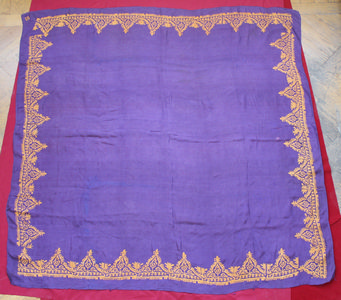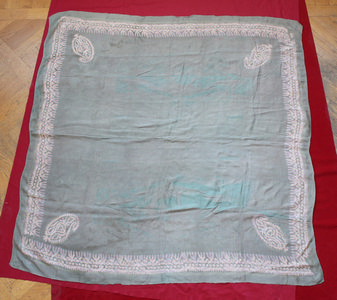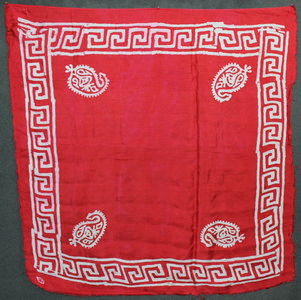Silk production in Azerbaijan
Silk production played such an important role in the Middle Ages and until the end of the 19th century as oil in the Azerbaijani economy today. The production of silk, which emerged in Azerbaijan in early Middle Ages, quickly became a household commodity and an important factor in the economic life of the population. Azerbaijani silk rapidly became the most important product of international trade. During the period of Arab Caliphate, the popularity of Azerbaijani silk greatly increased and it began to hold an important place in the world trade thanks to its high quality. The volume of silk production in Azerbaijan reached such a level that big volumes of silk were exported to foreign markets as it greatly exceeded the needs of the domestic market. Azerbaijan was able to greatly expand its domestic and international trade thanks to silk. Such Arab geographers as Ibn Hawqal, Al-Istakhri, Al-Muqaddasi and others said that Azerbaijani silk was very popular and a market called "Kurkiye" was established in Barda to sell silk. Arab geographer Yagut al-Hamawi (12th-13th century) wrote that a big volume of silk was exported from Barda and most of it was sent to Persia and Khuzistan.
Throughout the Middle Ages, Tabriz, as a capital city, was one of the leading cities in Azerbaijan in terms of both the production of a wide range of silk products and the level of development of textile technology. Satin and diba fabrics woven in Tabriz were very popular. Diba was woven with gold and silver threads. Silk weaving played a big part of Tabriz becoming the most commercially successful city in the Middle East. During that period, there was no other industry that brought as much money as silk weaving, both in the domestic market and in international trade. As the development of weaving in the European countries created a great demand for raw materials, the Netherlands, England, Spain, Portugal, etc. from the end of the 15th century till the beginning of the 16th century, began to obtain raw silk in the east, including from Azerbaijan. The interest in capturing these markets led to intense competition among the European countries in the 16th and 17th centuries. The export of raw silk and silk products played a decisive role in the formation of diplomatic relations of the Safavid Empire (which included Azerbaijan's territory) with foreign countries, including the European countries. It is no coincidence that throughout the history of the Safavid state, the issue of silk trade has always been the main topic of discussion in its diplomatic negotiations with the European countries and Russia.
Raw silk and a rich variety of silk products made from it became the main source of income for the state treasury. Mulberry cocoon production was considered as an important economic sector of state importance. Shah Abbas, who had a monopoly on the raw silk trade, set a new rule in 1599 that the entire raw silk produced in the country was to be sold only to the Shah's representatives.
Another important center of Azerbaijani silk production was the city of Shamakhi in the Middle Ages. Merchants from all over the world arrived here to buy silk. Merchants from Venice and Genoa arrived in Shamakhi in the 13th and 14th centuries. Shirvan merchants, who received official diplomatic assignments from the second half of the 15th century, often visited Tsar's Palace in Moscow as ambassadors. Big volumes of raw silk and silk fabrics was supplied from Shirvan to Russia. According to the sources, raw silk and silk products produced in Shamakhi, Sheki, Ganja, Tabriz, Ardabil and other Azerbaijani cities were mainly sold in the Russian market in the 15th century and they became widely known in the Russian cities.
After the Safavid shahs, the Beylerbeys also controlled the silk trade and were directly involved in it. Anthony Jenkinson was able to establish the English trade in Shamakhi with the help of Shirvan beylerbey Abdulla khan. Academician S.G.Gmelin, who visited Shirvan in the second half of the 18th century, wrote that Shamakhi gained glory and wealth thanks to its abundant silk. The Russian tsars made every effort in the 18th century to export Azerbaijani silk only to Russia. That is why they exempted silk from taxes to encourage traders who exported silk to Russia.
After Azerbaijan became the part of the Russian Empire, the government focused on the export of raw silk. Raw silk collected from the population in the form of taxes was returned to the central silk factories of Russia and after processing were sold at a high price. This way, local textile workshops were liquidated.
Calling the 50s and 60s of the 19th century as the "Golden Age of Caucasian Silk", researcher N.N.Shavrov wrote that during this period such a peak of development in silk production was reached that was not reached before or after that period.
By the end of the 19th century, local textile weaving process has already declined, and only the production of kelagayi (traditional Azerbaijani women's headgear) continued until the middle of the 20th century. Among the existing fields of production in Azerbaijan, silkworm breeding approached the level of manufacturing, but could not pass it. The world-famous silk fabrics woven in Azerbaijan can now be found only in museum collections.


